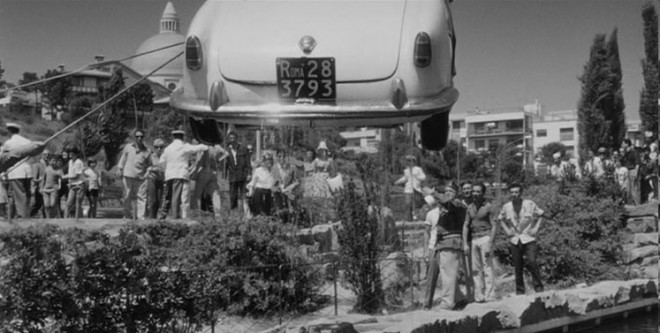January 30, 1972: Bloody Sunday, when British troops opened fire on a peaceful protest march by Catholics in Derry, thus ending for all time the Northern Ireland civil rights movement and reigniting the Irish Republican Army, for which the day’s horror provided a recruitment bonanza. British soldiers claimed they had been fired on first—a lie that an official inquiry at the time nevertheless backed, with Queen Elizabeth subsequently decorating those who had organized and perpetrated the massacre. No British soldiers were killed; in addition to the dozens of marchers and bystanders who were injured, thirteen persons were killed, including one who was shot in the back. “The gentle rainfall drifting down/ Over Colmcille’s town/ Could not refresh, only distil/ In silent grief from hill to hill.”*
Paul Greengrass’s heart-walloping Bloody Sunday, which took both the top prize, the Golden Bear, and the Ecumenical Jury Prize at Berlin in 2002, wears its bias for truth on its sleeve. (We can discount the small amount of foolishness, such as the fact that Greengrass’s script has the soldiers swearing and Irish Catholic mouths remaining pristine.) Beginning the night before the tragic event, the film employs the faux-newsreel handheld camera style of cinéma-vérité, which, coupled with the restricted time element, achieves great intensity. Reinforcing the film’s sense of unfolding reality is an impressionistic technique that divides the action into a series of seemingly camera-captured vignettes, most of relatively short duration, each consecutive two of which are separated by a faded-into blackout suggesting the operation of a camera shutter. This technique is abetted by the newspaper-style print used to identify scenes by time and location. Style, then, unifies the film.
The central character is Ivan Cooper, beautifully played by James Nesbitt (Best Actor, British Independent Film Awards, Stockholm Film Festival). A civil rights activist, Cooper is the idealistic organizer of the march. Unlike the overwhelming majority of the marchers, this Member of Parliament is Protestant; throughout the film, therefore, despite the viciousness of the intrusive British troops, Cooper holds out hope for us of the possibilities of justice, fairness, decency and humanity. Cooper’s mind and heart have long since convinced him of the wrongness of the inequality of rights borne by majority Protestants and minority Catholics in Northern Ireland. One should remain mindful of the existence of such people. Indeed, countless Protestants wanted British troops out of their country as much as Catholics did. At the end of the film, Cooper addresses the British for what they did on Bloody Sunday: “You will reap a whirlwind.” As Nesbitt enacts the moment of prophecy, Cooper’s sorrow is a match for his anger and disillusionment.
A finely gauged film, Bloody Sunday fully conveys the violence that the British soldiers unleashed while at the same time maintaining the distancing that’s the hallmark of genuine art. Greengrass keeps his aim always in the forefront of his mind; he wants to show us what happened so that we better understand why other things happened later. He doesn’t want to rub our faces into what happened and whip us into a frenzy of hate against the British. We never lose sight of the justice that Catholics in Northern Ireland merit.
The entire large cast is perfect, including Tim Pigott-Smith, Kathy Keira Clarke, Gerard Crossan and Allan Gildea. All the actors and actresses are largely responsible for the film’s riveting sense of realism.
In addition to its triumphs for Greengrass at Berlin, the film won as best film, Greengrass as best director and also as best scenarist at the Irish Film and Television Awards. Greengrass also won for the film or its direction at the Jerusalem Film Festival and the British Independent Film Awards. In the U.S., Bloody Sunday took the audience award at Sundance.
* These are the final lines of Thomas Kinsella’s great poem commemorating Bloody Sunday, Butcher’s Dozen: A Lesson for the Octave of Widgery. Colmcille refers to Saint Columbcille, the sixth-century monastic who prophesied the course of Irish history, including much that has unfolded and some that has yet to unfold.
